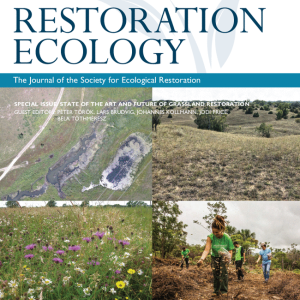
This special issue of the journal Restoration Ecology examines trends, opportunities and research gaps in the restoration of grassland ecosystems. TABLE readers may be particularly interested in the special issue’s coverage of grazing and land-use legacies.
The papers in the special issue are:
- Synthesis article: The present and future of grassland restoration
- Green hay transfer for grassland restoration: species capture and establishment
- Green hay application and diverse seeding approaches to restore grazed lowland meadows: progress after 4 years and effects of a flood risk gradient
- Establishment gaps in species‐poor grasslands: artificial biodiversity hotspots to support the colonisation of target species
- Effect of seed storing duration and sowing year on the seedling establishment of grassland species in xeric environments
- Super‐abundant C4 grasses are a mixed blessing in restored prairies
- Topsoil removal in degraded open sandy grasslands: can we restore threatened vegetation fast?
- Monitoring ecological characteristics of a tallgrass prairie using an unmanned aerial vehicle
- Reintroduced bison diet changes throughout the season in restored prairie
- Dynamics in vegetation and seed bank composition highlight the importance of post‐restoration management in sown grasslands
- Land‐use legacies limit the effectiveness of switches in disturbance type to restore endangered grasslands
- Long‐term effect of mowing on the restoration of Pannonian sand grassland to replace invasive black locust plantation
- Fire versus grazing as tools to restore serpentine grasslands under global change
- Restoration in the face of changing climate: importance of persistence, priority effects, and species diversity
- Effectiveness and costs of invasive species control using different techniques to restore cerrado grasslands
- Key issues in Northwestern Mediterranean dry grassland restoration
- A research agenda for the restoration of tropical and subtropical grasslands and savannas
Abstract of the synthesis article
Grasslands contribute greatly to biodiversity and human livelihoods; they support 70% of the world's agricultural area, but are heavily degraded by human land use. Grassland restoration research and management receives less attention than forests or freshwater habitats, although grasslands are critical for sustaining ecosystems multifunctionality and capacity to support biodiversity. In this article, we introduce a Special Issue which considers major trends and prospects in grassland restoration. We identified three key topics: First, restoration must confront widespread seed and site limitations, and new monitoring methods, including remote sensing techniques, are critical for restoration projects. Second, we highlight that restored grasslands typically require ongoing disturbance management and that research is required to determine optimal approaches for implementing this management during restoration. Third, global and regional restoration agendas should be harmonised with site‐level goals, and syntheses of current knowledge and research needs must guide grassland restoration across scales. We also identify research gaps to be filled, and challenges which grasslands face in the future: (1) a need for careful target vegetation selection and climate‐adaptive restoration; (2) lack of knowledge in dynamics and restoration of several regions and grassland types, including drylands and (sub)tropical regions; (3) increased importance of species arrival sequence, and high stochasticity of species establishment; and finally (4) issues of post‐restoration management to guarantee long‐term sustainability of restored sites. A new generation of research and restoration projects to bridge these gaps is necessary to mitigate environmental challenges spanning localities to the globe as we commence the UN Decade on Ecosystem Restoration.
Reference (synthesis article)
Török, P., Brudvig, L.A., Kollmann, J., N Price, J. and Tóthmérész, B., 2021. The present and future of grassland restoration. Restoration Ecology, 29, p.e13378.
Read the full special issue here. See also the TABLE explainer What is land use and land use change? and the report Grazed and Confused.







Post a new comment »